sensor TOYOTA RAV4 PHEV 2021 Owner's Guide
[x] Cancel search | Manufacturer: TOYOTA, Model Year: 2021, Model line: RAV4 PHEV, Model: TOYOTA RAV4 PHEV 2021Pages: 666, PDF Size: 161.28 MB
Page 341 of 666
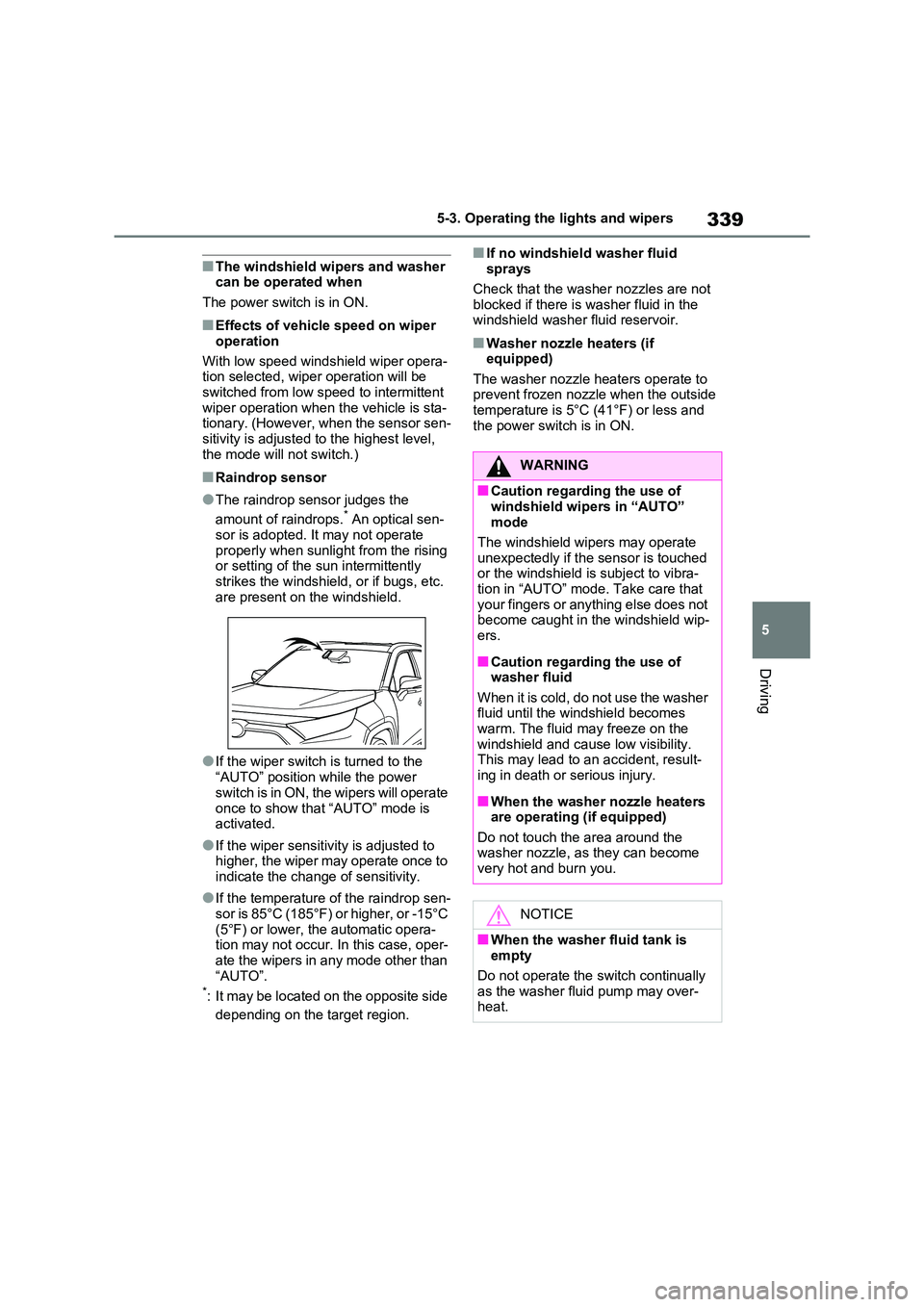
339
5
5-3. Operating the lights and wipers
Driving
■The windshield wipers and washer can be operated when
The power switch is in ON.
■Effects of vehicle speed on wiper
operation
With low speed windshield wiper opera -
tion selected, wiper operation will be
switched from low sp eed to intermittent wiper operation when the vehicle is sta -
tionary. (However, when the sensor sen -
sitivity is adjusted to the highest level, the mode will not switch.)
■Raindrop sensor
●The raindrop sensor judges the
amount of raindrops.* An optical sen - sor is adopted. It may not operate
properly when sunlight from the rising
or setting of the sun intermittently strikes the windshield, or if bugs, etc.
are present on the windshield.
●If the wiper switch is turned to the
“AUTO” position while the power
switch is in ON, the wipers will operate
once to show that “AUTO” mode is activated.
●If the wiper sensitivity is adjusted to higher, the wiper may operate once to
indicate the change of sensitivity.
●If the temperature of the raindrop sen -
sor is 85°C (185°F) or higher, or -15°C
(5°F) or lower, the automatic opera - tion may not occur. In this case, oper -
ate the wipers in any mode other than
“AUTO”.*: It may be located on the opposite side
depending on the target region.
■If no windshield washer fluid
sprays
Check that the washer nozzles are not
blocked if there is washer fluid in the
windshield washer fluid reservoir.
■Washer nozzle heaters (if equipped)
The washer nozzle heaters operate to
prevent frozen nozzle when the outside temperature is 5°C (41°F) or less and
the power switch is in ON.
WARNING
■Caution regarding the use of
windshield wipers in “AUTO” mode
The windshield wipers may operate
unexpectedly if the sensor is touched or the windshield is subject to vibra -
tion in “AUTO” mode. Take care that
your fingers or anything else does not become caught in the windshield wip -
ers.
■Caution regarding the use of
washer fluid
When it is cold, do not use the washer fluid until the windshield becomes
warm. The fluid may freeze on the
windshield and cause low visibility. This may lead to an accident, result -
ing in death or serious injury.
■When the washer nozzle heaters
are operating (if equipped)
Do not touch the area around the washer nozzle, as they can become
very hot and burn you.
NOTICE
■When the washer fluid tank is empty
Do not operate the switch continually
as the washer fluid pump may over - heat.
Page 346 of 666
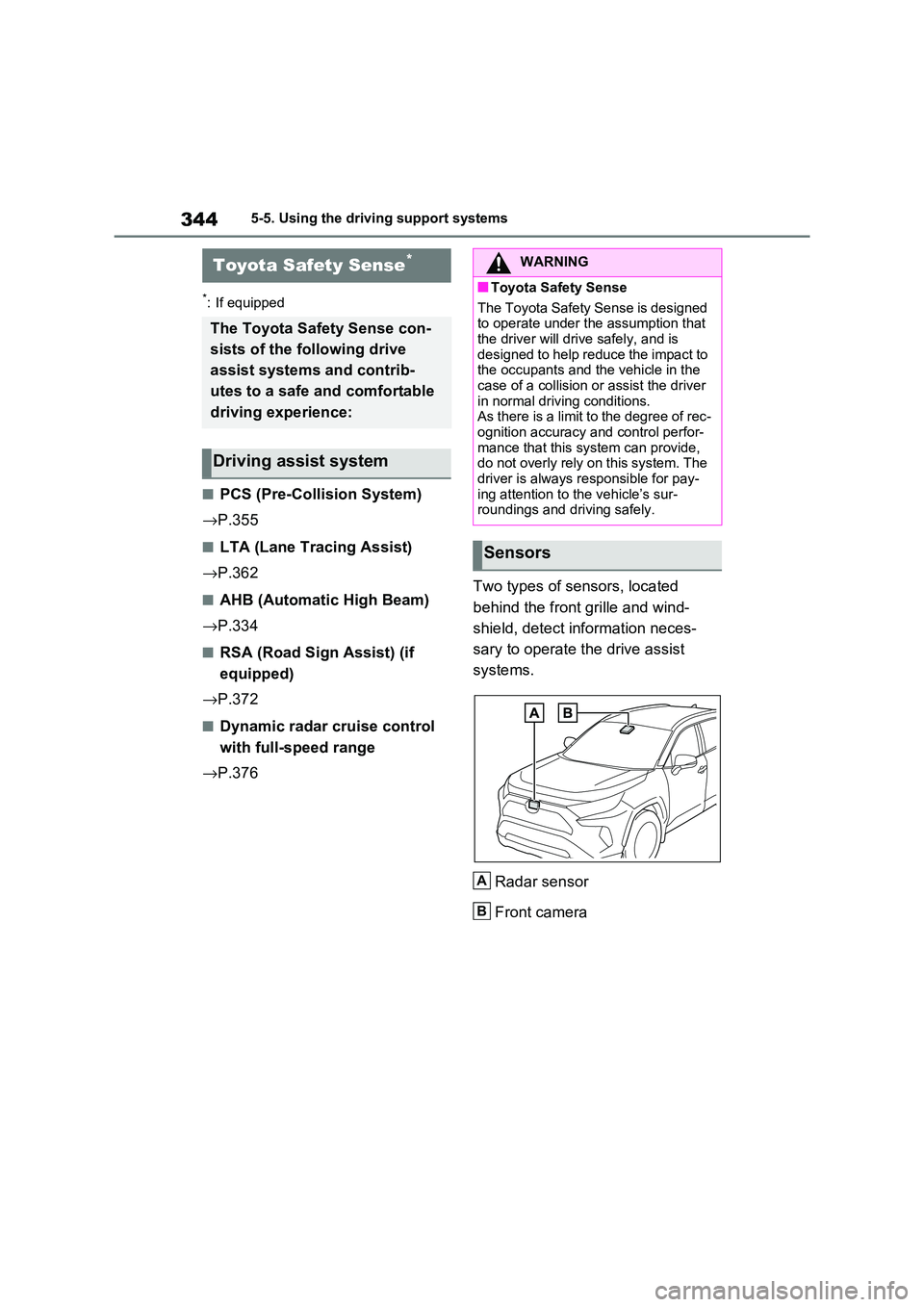
3445-5. Using the driving support systems
5-5.Using the driving support systems
*: If equipped
■PCS (Pre-Collision System)
→ P.355
■LTA (Lane Tracing Assist)
→ P.362
■AHB (Automatic High Beam)
→ P.334
■RSA (Road Sign Assist) (if
equipped)
→ P.372
■Dynamic radar cruise control
with full-speed range
→ P.376
Two types of sensors, located
behind the front grille and wind -
shield, detect information neces -
sary to operate the drive assist
systems.
Radar sensor
Front camera
Toyota Safety Sense*
The Toyota Safety Sense con -
sists of the f ollowing drive
assist systems and contrib -
utes to a safe and comfortable
driving experience:
Driving assist system
WARNING
■Toyota Safety Sense
The Toyota Safety Sense is designed
to operate under the assumption that the driver will drive safely, and is
designed to help reduce the impact to
the occupants and the vehicle in the case of a collision or assist the driver
in normal driving conditions.
As there is a limit to the degree of rec -
ognition accuracy and control perfor - mance that this system can provide,
do not overly rely on this system. The
driver is always responsible for pay - ing attention to the vehicle’s sur -
roundings and driving safely.
Sensors
A
B
Page 347 of 666
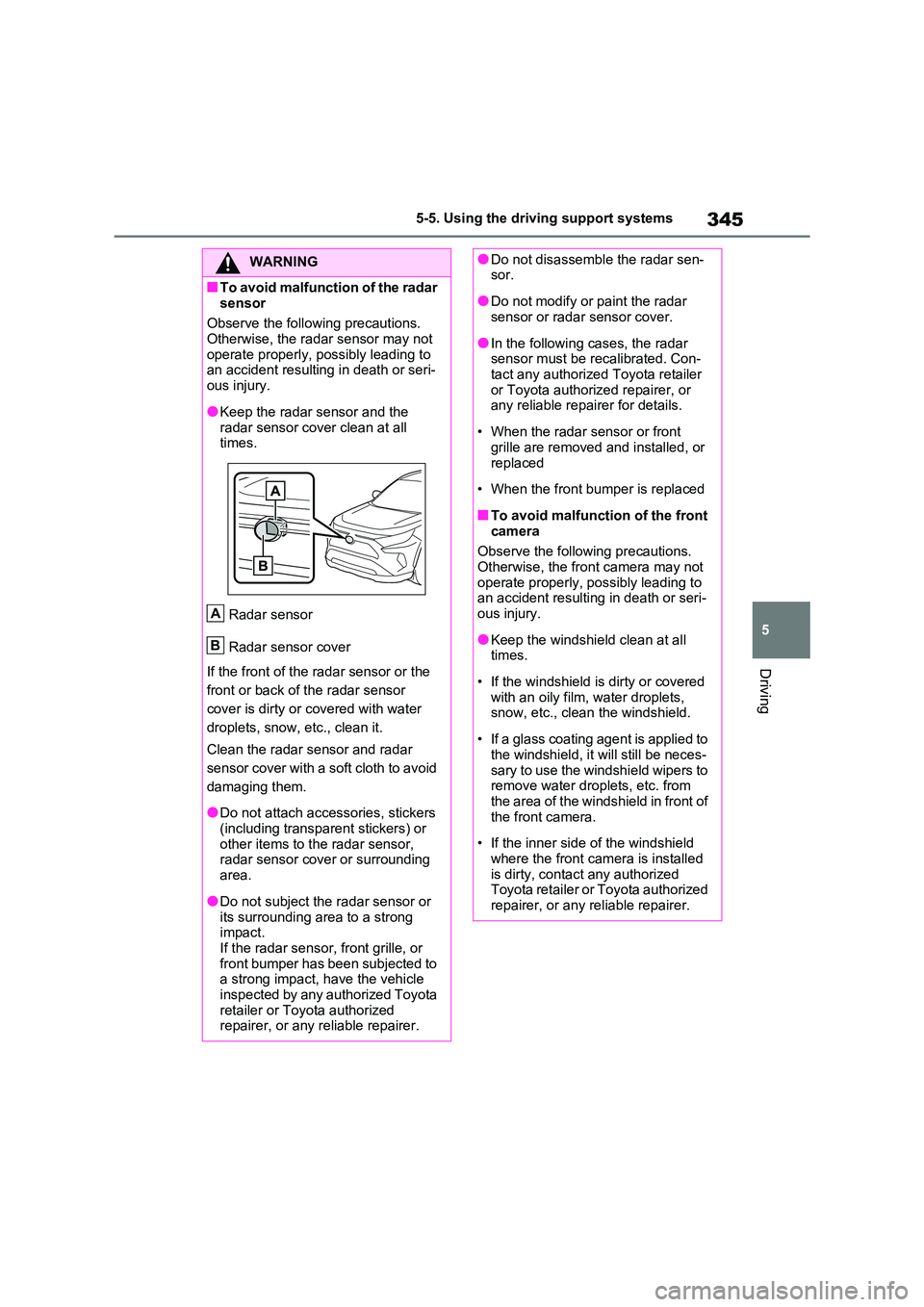
345
5
5-5. Using the driving support systems
Driving
WARNING
■T o av oi d ma lf u nct i on of the radar
sensor
Observe the following precautions. Otherwise, the radar sensor may not
operate properly, possibly leading to
an accident resulti ng in death or seri- ous injury.
●Keep the radar sensor and the
radar sensor cover clean at all times.
Radar sensor
Radar sensor cover
If the front of the radar sensor or the
front or back of t he radar sensor
cover is dirty or co vered with water
droplets, snow, etc., clean it.
Clean the radar sensor and radar
sensor cover with a soft cloth to avoid
damaging them.
●Do not attach acce ssories, stickers
(including transparent stickers) or
other items to the radar sensor, radar sensor cover or surrounding
area.
●Do not subject the radar sensor or
its surrounding area to a strong
impact. If the radar sensor, front grille, or
front bumper has been subjected to
a strong impact, have the vehicle
inspected by any authorized Toyota retailer or Toyota authorized
repairer, or any reliable repairer.
A
B
●Do not disassemble the radar sen - sor.
●Do not modify or paint the radar sensor or radar sensor cover.
●In the following cases, the radar sensor must be recalibrated. Con -
tact any authorized Toyota retailer
or Toyota authorized repairer, or any reliable repairer for details.
• When the radar sensor or front grille are removed and installed, or
replaced
• When the front bumper is replaced
■To avoid malfunction of the front camera
Observe the following precautions.
Otherwise, the front camera may not operate properly, possibly leading to
an accident resulting in death or seri -
ous injury.
●Keep the windshield clean at all
times.
• If the windshield is dirty or covered
with an oily film, water droplets, snow, etc., clean the windshield.
• If a glass coating agent is applied to the windshield, it will still be neces-
sary to use the windshield wipers to
remove water dropl ets, etc. from the area of the windshield in front of
the front camera.
• If the inner side of the windshield
where the front camera is installed
is dirty, contac t any authorized Toyota retailer or Toyota authorized
repairer, or any reliable repairer.
Page 355 of 666
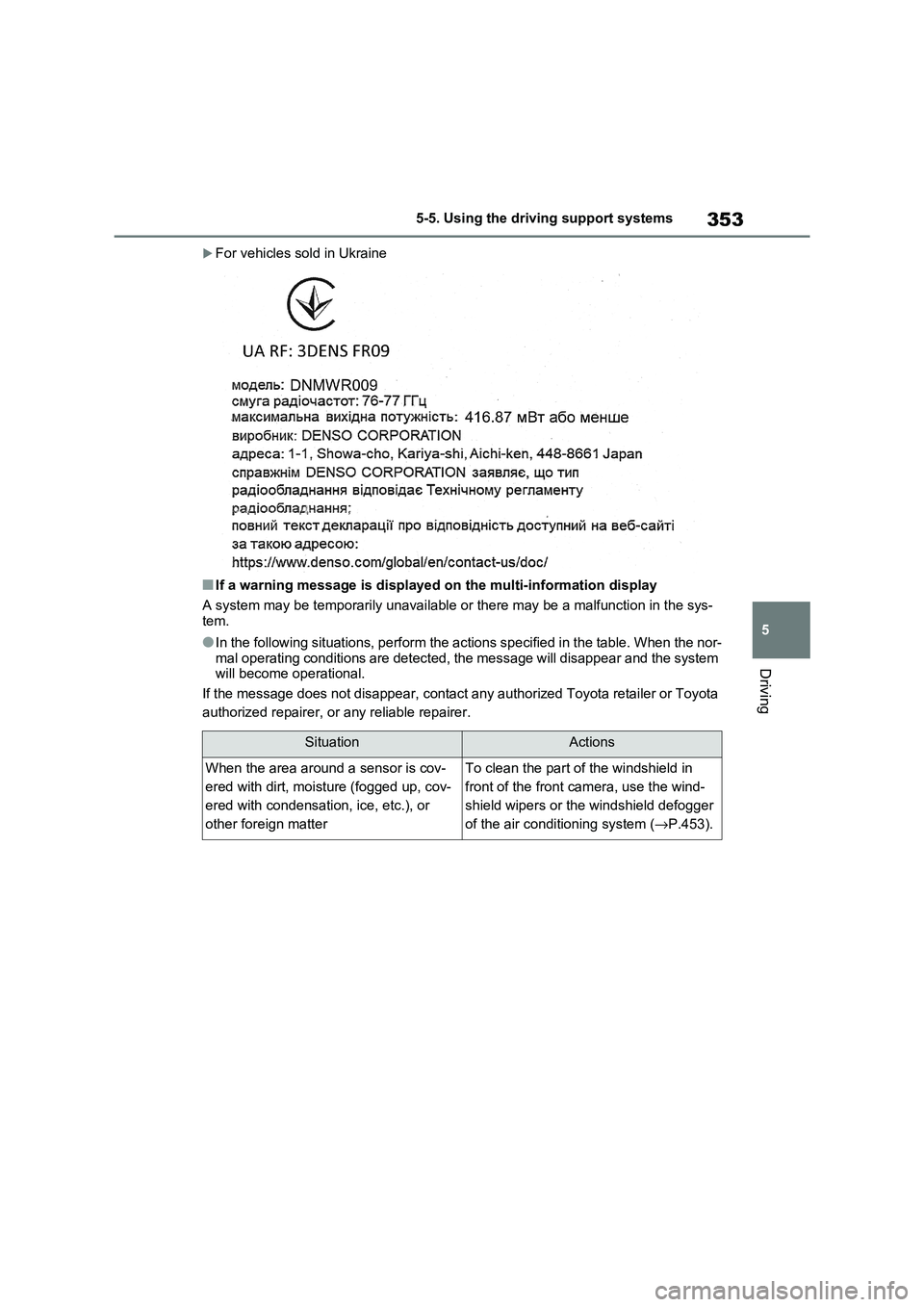
353
5
5-5. Using the driving support systems
Driving
For vehicles sold in Ukraine
■If a warning message is displayed on the multi-information disp lay
A system may be temporarily unavai lable or there may be a malfunction in the sys-
tem.
●In the following situations, perform the actions specified in t he table. When the nor-
mal operating conditions are detec ted, the message will disappear and the system
will become operational.
If the message does not disappear, contact any authorized Toyot a retailer or Toyota
authorized repairer, or any reliable repairer.
SituationActions
When the area around a sensor is cov -
ered with dirt, mois ture (fogged up, cov-
ered with condensation, ice, etc.), or
other fore ign matter
To clean the part of the windshield in
front of the front camera, use the wind -
shield wipers or the windshield defogger
of the air conditioning system ( →P.453).
Page 356 of 666
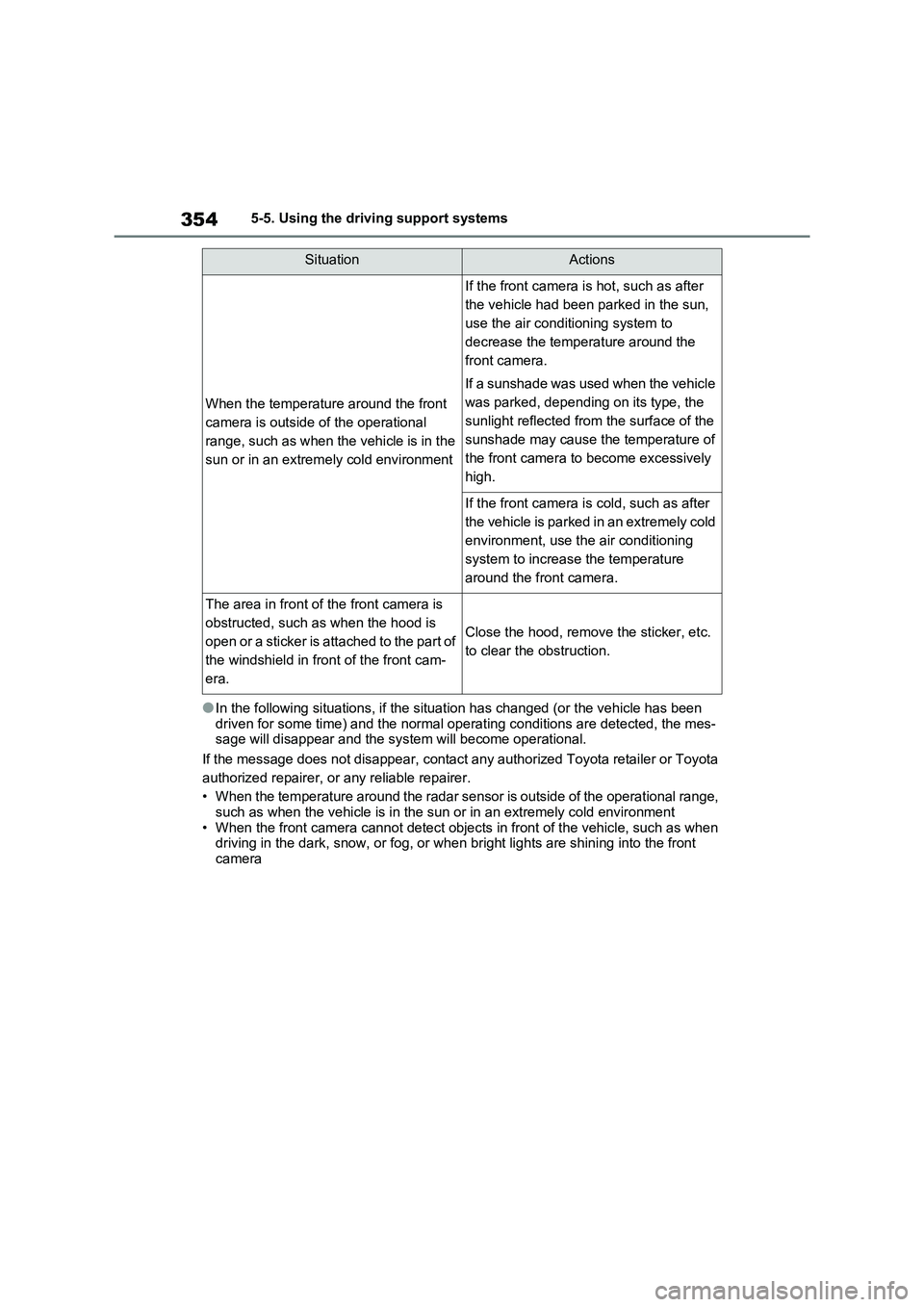
3545-5. Using the driving support systems
●In the following situations, if the situation has changed (or the vehicle has been
driven for some time) and the no rmal operating conditions are detected, the mes-
sage will disappear and the system will become operational.
If the message does not disappear, contact any authorized Toyot a retailer or Toyota
authorized repairer, or any reliable repairer.
• When the temperature around the radar sensor is outside of the operational range,
such as when the vehicle is in the sun or in an extremely cold environment
• When the front camera cannot detect objects in front of the vehicle, such as when driving in the dark, snow, or fog, or when bright lights are shining into the front
camera
When the temperatur e around the front
camera is outside of the operational
range, such as when the vehicle is in the
sun or in an extremely cold environment
If the front camera is hot, such as after
the vehicle had been pa rked in the sun,
use the air cond itioning system to
decrease the temperature around the
front camera.
If a sunshade was used when the vehicle
was parked, depending on its type, the
sunlight reflected from the surface of the
sunshade may cause t he temperature of
the front camera to become excessively
high.
If the front camera is cold, such as after
the vehicle is parked in an extremely cold
environment, use the air conditioning
system to increase the temperature
around the front camera.
The area in front of the front camera is
obstructed, such a s when the hood is
open or a sticker is attached to the part of
the windshield in front of the front cam -
era.
Close the hood, remove the sticker, etc.
to clear the obstruction.
SituationActions
Page 357 of 666
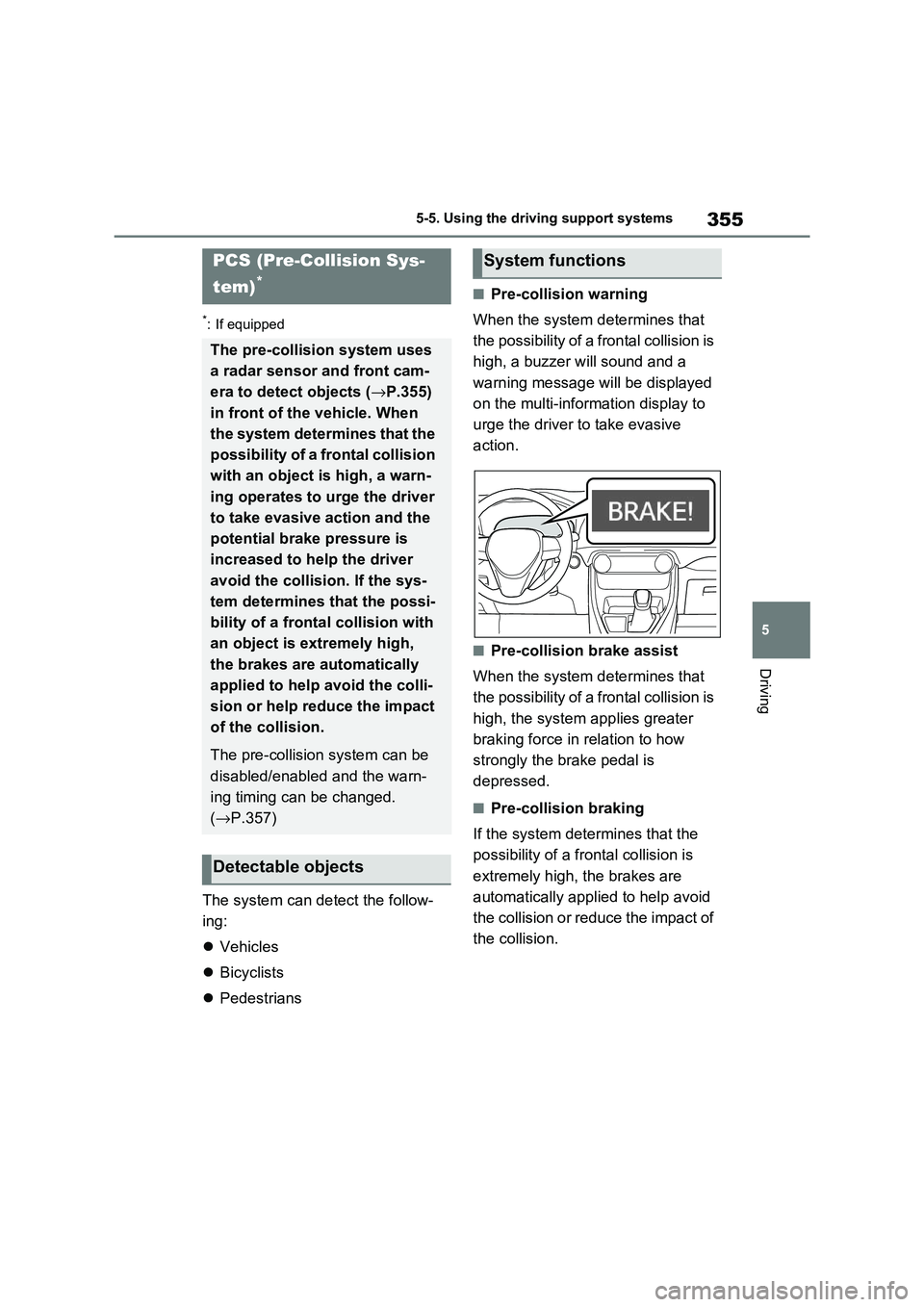
355
5
5-5. Using the driving support systems
Driving
*: If equipped
The system can detect the follow -
ing:
Vehicles
Bicyclists
Pedestrians
■Pre-collision warning
When the system determines that
the possibility of a frontal collision is
high, a buzzer will sound and a
warning message wil l be displayed
on the multi-information display to
urge the driver to take evasive
action.
■Pre-collision brake assist
When the system determines that
the possibility of a frontal collision is
high, the system applies greater
braking force in relation to how
strongly the brake pedal is
depressed.
■Pre-collision braking
If the system determines that the
possibility of a fr ontal collision is
extremely high, the brakes are
automatically applied to help avoid
the collision or reduce the impact of
the collision.
PCS (Pre-Collision Sys-
tem)*
The pre-collision system uses
a radar sensor and front cam -
era to detect objects ( →P.355)
in front of the vehicle. When
the system determines that the
possibility of a fr ontal collision
with an object is high, a warn -
ing operates to urge the driver
to take evasive action and the
potential brake pressure is
increased to help the driver
avoid the collision. If the sys -
tem determines that the possi -
bility of a fronta l collision with
an object is extremely high,
the brakes are automatically
applied to help avoid the colli -
sion or help reduce the impact
of the collision.
The pre-collision system can be
disabled/enabled and the warn -
ing timing can be changed.
( →P.357)
Detectable objects
System functions
Page 359 of 666
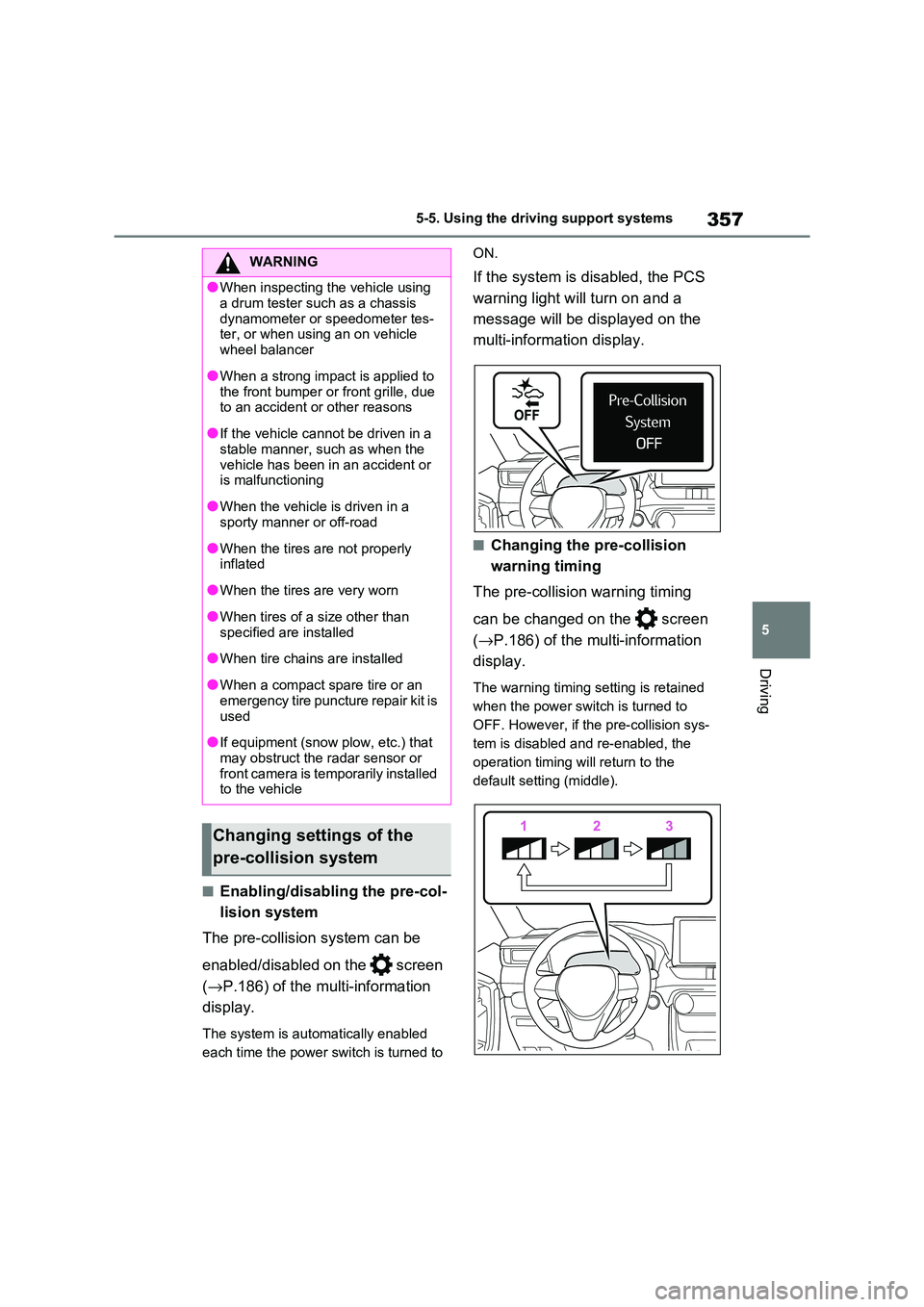
357
5
5-5. Using the driving support systems
Driving
■Enabling/disabling the pre-col -
lision system
The pre-collisio n system can be
enabled/disabled on the screen
( →P.186) of the multi-information
display.
The system is automa tically enabled
each time the power switch is turned to
ON.
If the system is disabled, the PCS
warning light will turn on and a
message will be di splayed on the
multi-information display.
■Changing the pre-collision
warning timing
The pre-collision warning timing
can be changed on the screen
( →P.186) of the multi-information
display.
The warning timing setting is retained
when the power switch is turned to
OFF. However, if the pre-collision sys-
tem is disabled and re-enabled, the
operation timing will return to the
default setting (middle).
WARNING
●When inspecting the vehicle using
a drum tester su ch as a chassis
dynamometer or speedometer tes- ter, or when using an on vehicle
wheel balancer
●When a strong impact is applied to
the front bumper or front grille, due
to an accident or other reasons
●If the vehicle cannot be driven in a
stable manner, such as when the
vehicle has been in an accident or is malfunctioning
●When the vehicle is driven in a sporty manner or off-road
●When the tires are not properly inflated
●When the tires are very worn
●When tires of a size other than
specified are installed
●When tire chains are installed
●When a compact spare tire or an
emergency tire puncture repair kit is
used
●If equipment (snow p low, etc.) that
may obstruct the radar sensor or front camera is tem porarily installed
to the vehicle
Changing settings of the
pre-collision system
Page 362 of 666
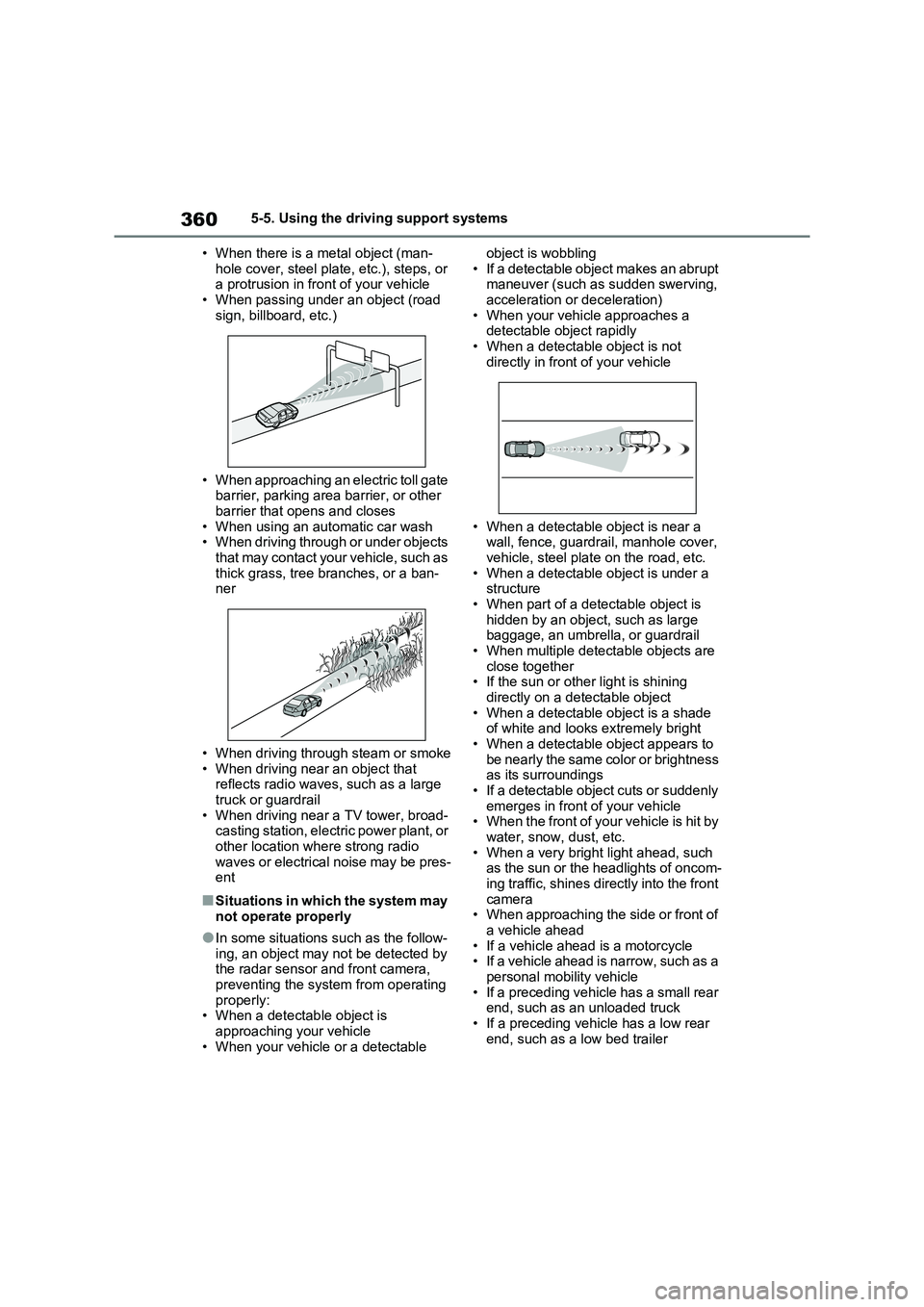
3605-5. Using the driving support systems
• When there is a m etal object (man-
hole cover, steel plate, etc.), steps, or a protrusion in front of your vehicle
• When passing under an object (road
sign, billboard, etc.)
• When approaching an electric toll gate
barrier, parking area barrier, or other barrier that opens and closes
• When using an automatic car wash
• When driving through or under objects that may contact your vehicle, such as
thick grass, tree branches, or a ban-
ner
• When driving through steam or smoke
• When driving near an object that reflects radio waves, such as a large
truck or guardrail
• When driving near a TV tower, broad - casting station, electric power plant, or
other location where strong radio
waves or electrical noise may be pres - ent
■Situations in which the system may
not operate properly
●In some situations such as the follow-
ing, an object may not be detected by
the radar sensor and front camera,
preventing the syst em from operating properly:
• When a detectab le object is
approaching your vehicle • When your vehicle or a detectable
object is wobbling
• If a detectable object makes an abrupt maneuver (such as sudden swerving,
acceleration or deceleration)
• When your vehicle approaches a detectable object rapidly
• When a detectabl e object is not
directly in front of your vehicle
• When a detectable object is near a
wall, fence, guardrail, manhole cover, vehicle, steel plate on the road, etc.
• When a detectable object is under a
structure • When part of a detectable object is
hidden by an object, such as large
baggage, an umbrella, or guardrail • When multiple detectable objects are
close together
• If the sun or othe r light is shining directly on a de tectable object
• When a detectable object is a shade
of white and looks extremely bright • When a detectable object appears to
be nearly the same color or brightness
as its surroundings • If a detectable object cuts or suddenly
emerges in front of your vehicle
• When the front of your vehicle is hit by water, snow, dust, etc.
• When a very brigh t light ahead, such
as the sun or the headlights of oncom - ing traffic, shines directly into the front
camera
• When approaching the side or front of a vehicle ahead
• If a vehicle ahea d is a motorcycle
• If a vehicle ahead is narrow, such as a
personal mobility vehicle • If a preceding vehicle has a small rear
end, such as an unloaded truck
• If a preceding vehicle has a low rear end, such as a low bed trailer
Page 363 of 666
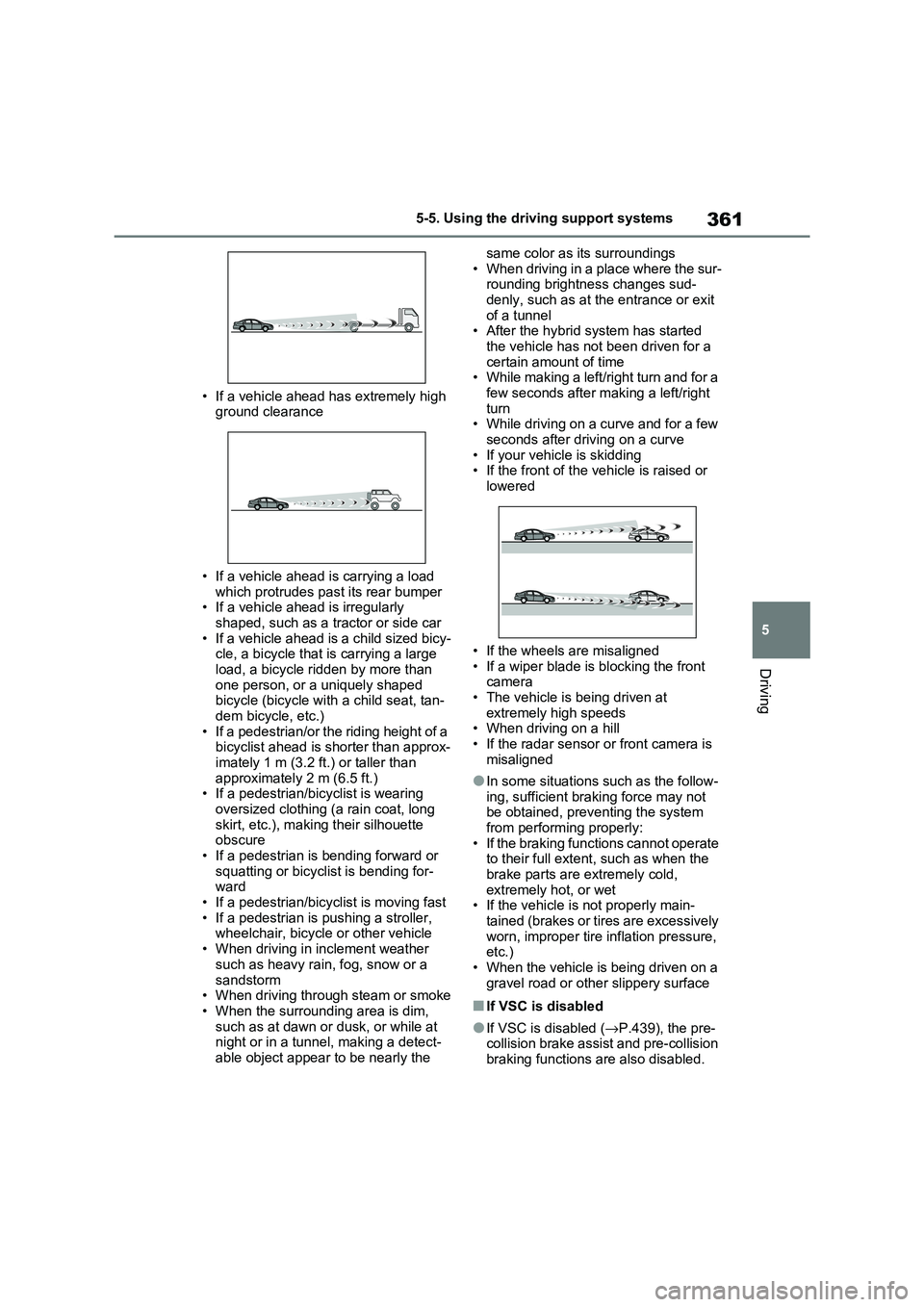
361
5
5-5. Using the driving support systems
Driving
• If a vehicle ahead has extremely high
ground clearance
• If a vehicle ahead is carrying a load
which protrudes pa st its rear bumper • If a vehicle ahead is irregularly
shaped, such as a tractor or side car
• If a vehicle ahead is a child sized bicy - cle, a bicycle that is carrying a large
load, a bicycle ridden by more than
one person, or a uniquely shaped bicycle (bicycle with a child seat, tan-
dem bicycle, etc.)
• If a pedestrian/or the riding height of a bicyclist ahead is shorter than approx -
imately 1 m (3.2 ft.) or taller than
approximately 2 m (6.5 ft.) • If a pedestrian/bi cyclist is wearing
oversized clothing (a rain coat, long
skirt, etc.), maki ng their silhouette obscure
• If a pedestrian is bending forward or
squatting or bicyclist is bending for - ward
• If a pedestrian/bicy clist is moving fast
• If a pedestrian is pushing a stroller, wheelchair, bicycle or other vehicle
• When driving in inclement weather
such as heavy rain , fog, snow or a
sandstorm • When driving through steam or smoke
• When the surrounding area is dim,
such as at dawn or dusk, or while at night or in a tunnel, making a detect -
able object appear to be nearly the
same color as its surroundings
• When driving in a place where the sur - rounding brightness changes sud -
denly, such as at the entrance or exit
of a tunnel • After the hybrid system has started
the vehicle has not been driven for a
certain amount of time • While making a left/right turn and for a
few seconds after making a left/right
turn • While driving on a curve and for a few
seconds after driving on a curve
• If your vehicle is skidding • If the front of the v ehicle is raised or
lowered
• If the wheels are misaligned
• If a wiper blade is blocking the front
camera • The vehicle is being driven at
extremely high speeds
• When driving on a hill • If the radar sensor or front camera is
misaligned
●In some situations such as the follow -
ing, sufficient braking force may not
be obtained, preventing the system from performing properly:
• If the braking functions cannot operate
to their full extent, such as when the brake parts are extremely cold,
extremely hot, or wet
• If the vehicle is not properly main - tained (brakes or ti res are excessively
worn, improper tire i nflation pressure,
etc.)
• When the vehicle is being driven on a gravel road or other slippery surface
■If VSC is disabled
●If VSC is disabled (→P.439), the pre- collision brake assist and pre-collision
braking functions are also disabled.
Page 373 of 666
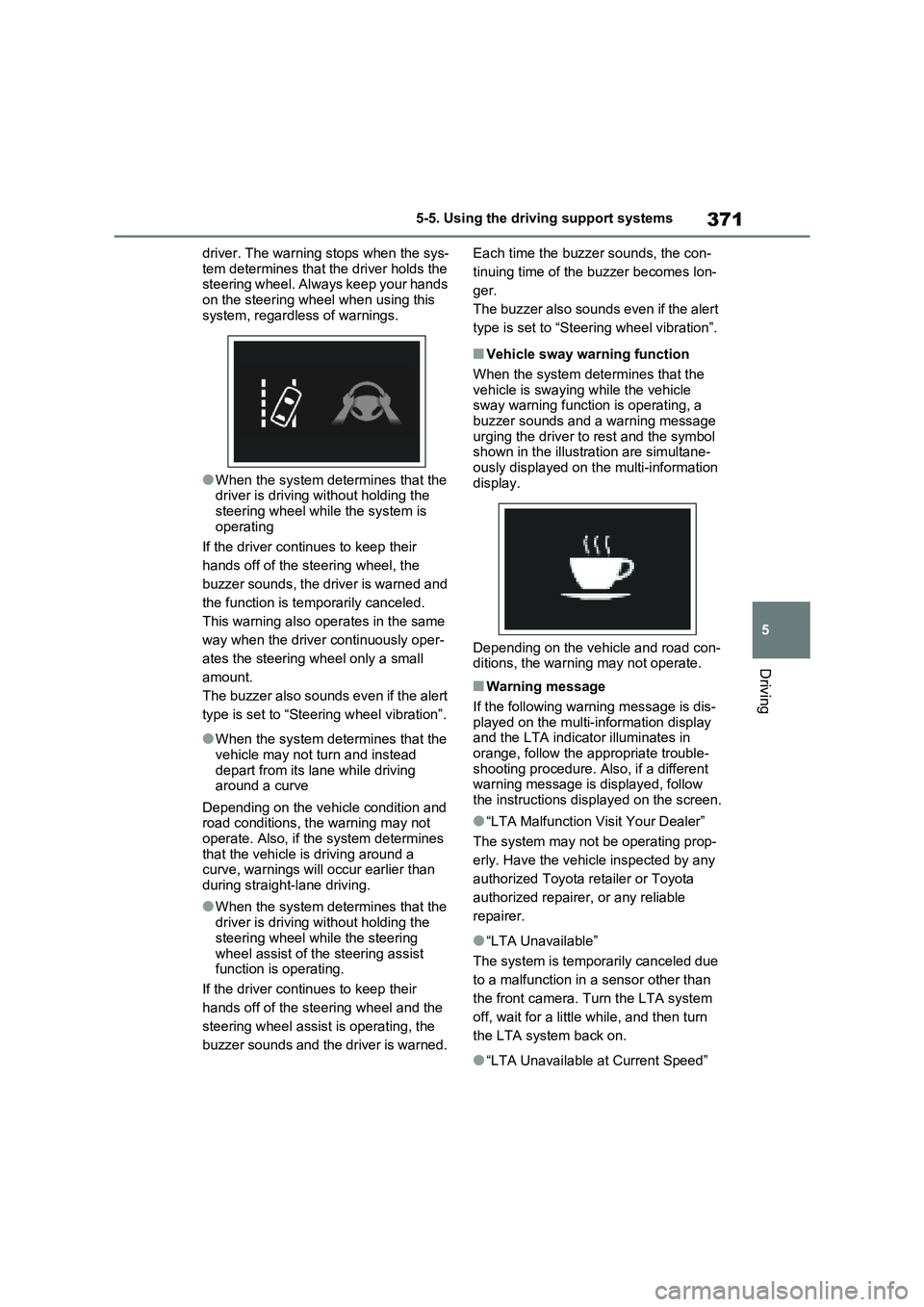
371
5
5-5. Using the driving support systems
Driving
driver. The warning stops when the sys -
tem determines that the driver holds the steering wheel. Always keep your hands
on the steering wheel when using this
system, regardless of warnings.
●When the system det ermines that the
driver is driving without holding the steering wheel wh ile the system is
operating
If the driver continues to keep their
hands off of the steering wheel, the
buzzer sounds, the driver is warned and
the function is te mporarily canceled.
This warning also operates in the same
way when the driver continuously oper -
ates the steering w heel only a small
amount.
The buzzer also sounds even if the alert
type is set to “Steering wheel vibration”.
●When the system det ermines that the
vehicle may not t urn and instead
depart from its lane while driving around a curve
Depending on the vehicle condition and road conditions, the warning may not
operate. Also, if t he system determines
that the vehicle is driving around a curve, warnings will occur earlier than
during straight-lane driving.
●When the system det ermines that the
driver is driving without holding the
steering wheel while the steering
wheel assist of the steering assist function is operating.
If the driver continues to keep their
hands off of the steering wheel and the
steering wheel assist is operating, the
buzzer sounds and the driver is warned.
Each time the buzze r sounds, the con-
tinuing time of the buzzer becomes lon -
ger.
The buzzer also sounds even if the alert
type is set to “Steering wheel vibration”.
■Vehicle sway wa rning function
When the system det ermines that the
vehicle is swaying while the vehicle sway warning function is operating, a
buzzer sounds and a warning message
urging the driver to r est and the symbol shown in the illustration are simultane -
ously displayed on the multi-information
display.
Depending on the vehicle and road con -
ditions, the warning may not operate.
■Warning message
If the following warning message is dis -
played on the multi-information display
and the LTA indicator illuminates in orange, follow the appropriate trouble -
shooting procedure. A lso, if a different
warning message is displayed, follow the instructions dis played on the screen.
●“LTA Malfunction Visit Your Dealer”
The system may not be operating prop-
erly. Have the vehicle inspected by any
authorized Toyota r etailer or Toyota
authorized repairer, or any reliable
repairer.
●“LTA Unavailable”
The system is temporarily canceled due
to a malfunction in a sensor other than
the front camera. Tu rn the LTA system
off, wait for a little while, and then turn
the LTA system back on.
●“LTA Unavailable at Current Speed”